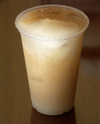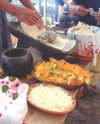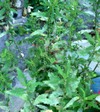
If you’ve shopped at any of Mexico’s thousands of tianguis (street markets), you may have wondered what certain vendors were ladling out of their frosty garafas (stainless steel containers). That’s tejuino. Along many highways and byways, you’ll regularly see someone selling aguamiel and pulque, the ancient drink of the Aztecs, from large jars positioned on a tiny table.
If you’ve wandered along the magical beaches bordering Mexico’s western coastlines,
you may have noticed a man with a yoke-like pole across his shoulders,
a red painted gourd suspended from the pole by a rope. His cry is
"Tuba! Tubaaaaaaaaaaa!" and his hands are full of plastic cups. At
various hole-in-the-wall supper restaurants, pineapple tepache
is the order of the day, served fizzing with a pinch of bicarbonate of
soda. And on the outskirts of one small town as I head for Guadalajara and home, a sign hangs from a guamúchil tree. It reads "Aquí Se Vende Pajarete" (Pajarete Sold Here) and advertises yet another unusual beverage.
I don’t expect you to whip up most of these six popular drinks in your
home kitchen, but I thought you’d love knowing about some of Mexico’s really unusual cold drinks.
Tejuino
Since ancient times, cooling tejuino has refreshed Mexico. It’s made from the same corn masa (dough) that’s used for tortillas and tamales. The prepared masa is mixed with water and piloncillo
(cone-shaped Mexican brown sugar) and boiled until the liquid is quite
thick. It’s then allowed to ferment slightly—but just slightly. I’ve
never known anyone to get so much as a buzz from sipping a cupful of
cold tejuino.
Once the tejuino is thickened and fermented, it’s mixed as needed with freshly squeezed jugo de limón
(key lime juice), a pinch of salt, water, ice, and a big scoop of lemon
sherbet. Just about everywhere in Mexico, it’s sold in plastic glasses—small,
medium, and large—or in a plastic bag with the top knotted around a
drinking straw.
Some people say that tejuino is an acquired taste. I
acquired the taste for it the very first time I tried it and often
crave it on hot afternoons. There is nothing more
refreshing. Fortunately, there is a tejuino vendor just a block from my house, so I can buy a glassful when the spirit moves me. Cup after cup of freshly prepared tejuino is ladled out to customers every day. Although tejuino is only a slightly sweet
drink, the masa base makes tejuino very filling. A small glass is usually very satisfying.
Pulque
In the early 1980s while I was living in Mexico City, a friend took me
to meet some of her friends in a tiny town in the State of Mexico, which surrounds Mexico City. I
ate and drank things that I’d never seen before, including blue corn quesadillas washed down with pulque. The quesadillas were delicious. I was a bit uncertain about trying the pulque—I’d heard certain things about it.

Pulque is harvested from mature maguey plants that have reached heights of over eight feet by the time they’re seven to ten years old. Once a plant is mature, a pulque
harvester prunes off the top, carves out a reservoir in the center of
the plant, and then covers the opening. Juice from the plants’ leaves
drains into the reservoir and the liquid, called aguamiel, is harvested twice a day by the farmers. A typical maguey plant yields more than a gallon of aguamiel twice a day for several months. There are tales of legendary magueyes which have produced nectar for a year.
Harvesters store the juice in vats, where naturally occurring bacteria
from the plant cause it to ferment. Within the course of a day or two,
it reaches six percent alcohol. It’s often cured with pineapple,
strawberries, guavas, or other fresh seasonal fruit to give it
delicious flavor. It has more alcohol than beer, but less than wine.
It’s rich in vitamins, minerals, and amino acids—in fact, it’s said to
be almost as good for you as chicken soup!
Indigenous peoples in this country discovered the heady
beverage over 2,000 years ago. It became the elixir of choice for Aztec
leaders, who occasionally shared it with their subjects. About-to-be
human sacrifices were given pulque before they were killed. Aztec legend tells of a leader who got drunk on pulque
and removed his clothes in public. The shamed man was banished to a
remote area, where he and his followers enjoyed a lifestyle rich in pulque parties and frequent nudity.
That tale may shed light on the certain things that I’d heard: the most celebrated characteristic of pulque is that it’s alleged to have an aphrodisiac property. Ask any Mexican male, and he’ll say, ‘Ooh, pulque makes you very strong!’
Over the centuries, pulque morphed from royal nectar to a blue-collar beverage enjoyed mainly in pulquerías: gritty, working-class, men-only establishments. When my friends in the State of Mexico saw a pulque
vendor outside a produce market, they insisted, with much laughing and
poking each other with elbows, that I try it. Remember that I’d heard things about it. Tasting the pulque made me nervous, since what I’d heard was that decent women didn’t drink pulque, that it was slimy and bad-tasting and that it quickly made one very drunk.
Peer pressure got to me and I took a sip and discovered that I liked it
very much, perhaps because it was cured and flavored with fresh
strawberries. I downed the small cup my friends gave me and asked for
another. It reminded me of hard cider, with that same kind of light
bubbly feel in the mouth. I quickly discovered that it affected me the
same way hard cider does—with that same kind of light bubbly feel in
the head, the feeling that makes it hard to walk straight. My friends
laughed all the harder as I acted sillier and proclaimed that I really,
really liked the pulque—the very same beverage I had protested against just a few minutes earlier.
Aguamiel
Aguamiel is the fresh, uncured juice of the maguey. At the time the mature maguey is topped, some of the juice is taken out of the plant’s center reservoir and drunk as is. A single maguey plant can produce as much as 2,500 liters of aguamiel over the course of several months. Aguamiel is non-alcoholic, fresh-tasting, and very thirst-quenching. It has the same medicinal properties as pulque.
Old traditions called for growers to plant and later top the maguey
with religiously fervent reverence. The farmer begged the plant to grow
well, to weep, and to fill up with aguamiel. The practice was considered to be idolatrous, because the farmer was treating a simple plant as if it were a god.
In today’s fields all across Mexico, there are farmers who continue to
practice the old rituals. When the mature plant begins to grow its
flower spike, the spike is cut away from the heart of the maguey,
leaving an opening 20 to 30 centimeters in diameter (approximately one
foot). The opening in the top of the plant is covered by several of the
plant’s own leaves, which are folded over and pinned down with the
long, sharp needles that grow along the leaves’ edges. In that way, the
plant protects itself from insects and dirt and can be opened twice a
day to remove the aguamiel.
Tuba
In Mexico, tuba is primarily a coastal drink. Several years ago I was surprised to see a tuba vendor at a tianguis in Guadalajara. Now I’ve been seeing the same man selling tuba in Tlaquepaque and at the Thursday and Sunday artisans’ tianguis in Tonalá. If you happen to be in this area, look for him—he’s easy to spot, with his bright-red gourd of tuba suspended from a pole across his shoulders.
Coconut palm sap is fermented to make the clear, white, sweet wine called tuba.
To collect the sap, workers climb the palm tree in the morning and
evening and bruise the coconut flower stalk until it starts to ooze its
liquid. The stalk is tied with bamboo strips into a special bamboo
container to catch the sap. Crushed tanbark from the mangrove tree is
dropped into the container to give the sap a reddish color and to
hasten its fermentation. As many as three flowers from one coconut tree
can be made to yield sap. Each flower produces tuba for two months, after which it dries out and is cut from the tree.
The liquid actually begins to ferment while still in the bamboo
container on the tree, but the alcohol content increases considerably
with longer fermentation. Tuba quenches the thirst, is good for indigestion, and makes conversation flow easily.
Tepache
I’ve found tepache in several cenadurías
(restaurants open for supper only, usually from 7:30 PM until midnight)
in Mexico, as well as at street stands. Tepache is simple to make and the ingredients are readily available whether
you live North or South of the Border. You might like to try this at
home.
Tepache (teh-PAH-cheh)
1 whole pineapple (about 3 pounds)
3 quarts water
1 pound piloncillo or brown sugar
1 cinnamon stick, approximately 3" long
3 clovesWash the pineapple well. Cut off the stem end and discard. Leave the
skin on the pineapple and cut the entire fruit into large pieces.Place the pieces of pineapple in a large container and add two quarts of water, the piloncillo
or brown sugar, the cinnamon, and the cloves. Cover and allow to rest
in a warm place for approximately 48 hours. The longer you allow the
liquid and fruit to rest, the more it will ferment. If you let it sit
for longer than 48 hours, taste it periodically to make sure it is not
overly fermented, as it will go bad.Strain the liquid—the tepache—and add the last quart of water.
If you prefer, do not add the last quart of water. Instead, add one cup of beer and allow to rest for another 12 hours.
Strain again and, if you have used the beer, add three cups of water.
Serve cold with ice cubes.
At any cenaduría, you can ask for your tepache
with a pinch of bicarbonate of soda. You can also add it at home, just
before you’re ready to drink a glassful. The addition makes the tepache
fizz and bubble, and it’s said to be extremely good for the digestion.
An elderly neighbor of mine swears by it as a heartburn remedy.
Pajarete
In the Mexican countryside, tequila drinking
starts as soon as the sun comes up. If you drive Mexican highways early any
morning—early, please, when the air is still chilly and cool gray mist
clings to the flanks of the mountains of the Central Highlands—look for a small hand painted
sign. "Aquí Se Vende Pajarete" (pah-hah-REH-teh)
is all it says. The sign may hang from a tree, it may be tacked to a fencepost, and you won’t see any indication of a cart or stand.
Back from the road, behind the trees, past the bushes, just over there by those old wrecked cars, a dairy farmer milks his cows. As he milks the patient cows and they snuffle their hot breath into the misty morning, groups of men (sombrero-wearing men who are real men) gather around the cow lot, each man with his large clay mug. Into each mug go a stiff shot of either charanda (a kind of grain alcohol) or tequila, a bit of sugar and some cinnamon-laden Mexican chocolate grated from a round tablet. The mug is then filled with warm milk, freshly squeezed directly into the mug from the cow. More a body-temperature drink than a cold drink, that’s pajarete: breakfast of champions.
There are many more interesting and unusual drinks South of the Border, everything from A (acachú, a drink made near Puebla from the wild cherry) to Z (zotol,
made in Chihuahua from the sap of wild yucca). Wherever you are in
Mexico, you’ll find something fascinating to quench your thirst, make
you feel more at home in the culture, and give you a story to tell.
A toast to each of you: Salud, dinero, y amor, y tiempo para gozarlos. Health, money, and love, and time to enjoy them.












